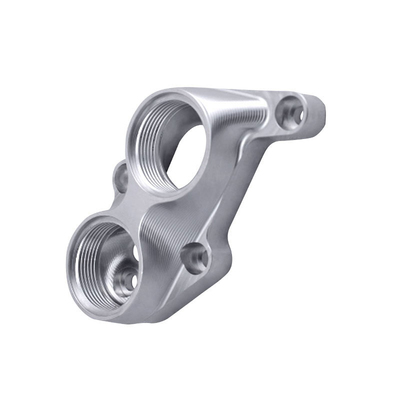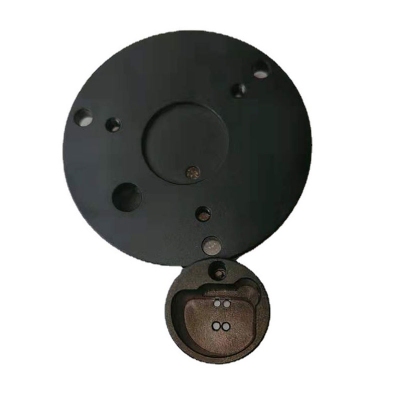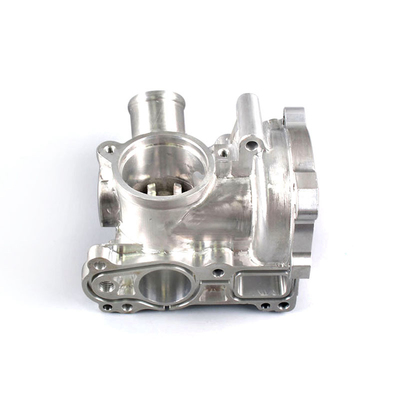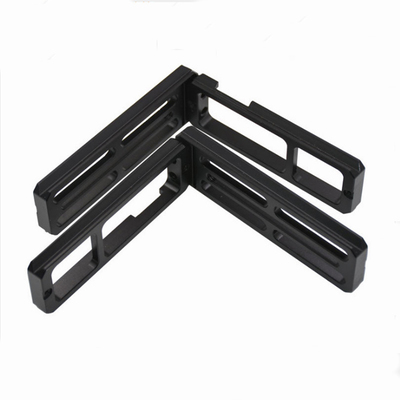Processing skills of four difficult-to-process metal materials
When selecting challenging metals for processing, economic efficiency is an important consideration.
CBN inserts with enhanced chamfered edges eliminate edge cracks that are common when cutting materials with hardness greater than 50 RC.
Full-hardened steel, hard powder metal, heat-resistant superalloys and bimetals have all been widely recognized in the industry. Although such materials can provide almost indestructible parts, their machining has encountered difficulties: how to machine them into the final shape at a reasonable part cost. Fortunately, cutting tool suppliers have made great strides in inserts for milling and turning difficult materials.
Today's coated carbide, cermet, cubic boron nitride (CBN) and polycrystalline diamond (PCD) blades all play a role. The advanced material blade with special geometry and coating can withstand mechanical shock and heat resistance, while also resisting abrasive wear. However, effective use of these blades may require various external factors, one of which may be a partnership with an experienced tool supplier.
Since the cost of cutting inserts is relatively low (usually the use of cemented carbide inserts only accounts for 3% of the total processing cost, while the use of CBN inserts only accounts for 5% to 6%), so using cheap inserts may be a wrong economy practice. Advanced material inserts can shorten cycle time or get more quality parts for each shift, thus recovering costs.
How to significantly reduce 5-axis finishing time
On the other hand, unnecessarily filling a large milling cutter with foreign inserts is a costly mistake. The cost of CBN inserts is eight to ten times that of cemented carbide. Running these advanced material blades at the wrong speed and feed rate can compromise part quality and tool life. In the case of inventory difficulties, choosing the right blade requires consideration of both processing economics and the entire process.
Use the correct feed and speed
Consider the entire application. Considering the time it takes to index and replace the blade, cheaper carbide blades that can play a role in tolerance and surface finish can be expensive. Real productivity comes from an understanding of the trade-offs between throughput, cycle time and blade performance.
In a professional, small batch example, sintered titanium carbide gas turbine blades were successfully milled with coated carbide cutting inserts. At 120 sfm, the carbide cutting edge can only cut 5 to 10 minutes. In mass production, materials that are difficult to process usually set the acceptable blade life at 15 to 30 minutes, but for low-speed parts, short blade life and frequent tool changes are not the main disadvantages. Longer blade life has indeed become important in the entire production. However, it is necessary to reduce the downtime and labor for tool change, and to improve machine utilization and productivity. Cemented carbide is currently well used for turbine blades, but if parts are to be produced in higher volumes, this application may justify the use of harder, more expensive blades made of CBN.
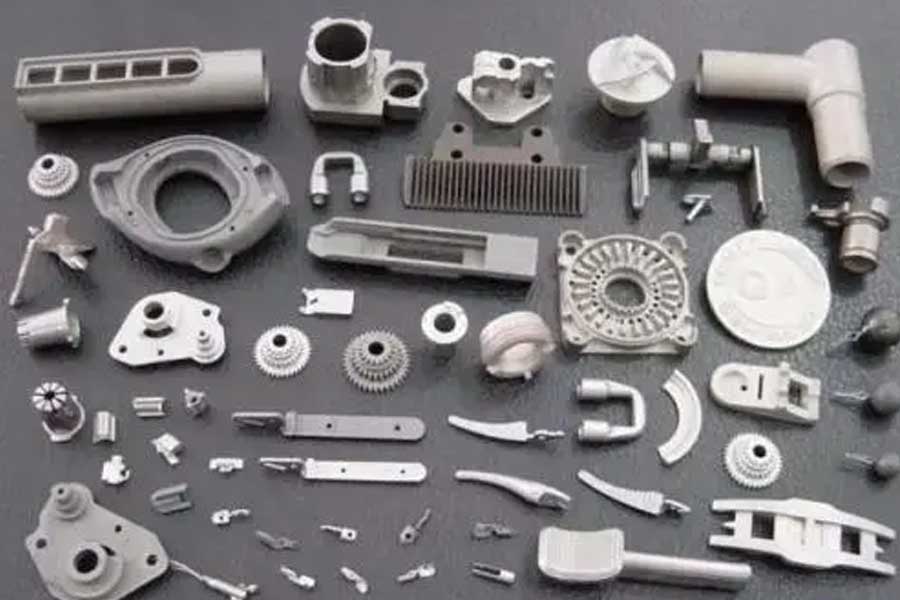
To use advanced material blades to increase productivity, the correct feed and speed must be used. Sandvik Coromant’s CBN inserts have a reinforced chamfered edge to eliminate edge cracks that are common when cutting hard materials above 50 RC. Despite this toughness, CBN inserts still require cutting machine parameters to maintain strict tolerances. Cutting speed is too low 10% or too high 10% will seriously affect performance.
If you need to machine difficult materials, please consider contacting the cutting tool supplier. Suppliers can provide solutions based on how others solve the same problem. When a test is required, it usually starts with a hard alloy blade and then uses a harder and more expensive tool. Modern blade geometry, rigid tool holders and sophisticated machining procedures usually make lower-cost carbide blades suitable for hard work. When to surpass carbides will vary from application to application, but a variety of materials does present common processing challenges.
Hardened steel
Steel alloys used in many applications are becoming harder and harder. Although tool steel was once considered a hard material of 45 RC, steel hardened to 63 RC is now common in the mold industry. Mold manufacturers who used to cut parts only before heat treatment are now precision machined tool steels in a fully hardened state to avoid heat treatment distortion. The heat and pressure encountered when milling a fully hardened alloy can cause plastic deformation of the cutting insert and rapid blade failure.
Even so, fully hardened steel can be processed economically with carbides. One example involves aerospace processing. A major aerospace manufacturer chose Sandvik GC1025 cemented carbide inserts to re-drill large forgings of 4340 modified hardened 300M section steel. When the steel has a hardness of 30 to 32 RC, most of the metal will be removed before heat treatment. However, in order to correct the deformation, once the workpiece is completely hardened to 54 or 55 RC, it is necessary to re-drill the large workpiece.
A particularly challenging feature deep in the part requires three boring passes to achieve the required tolerance and finish. In less than one time, the combination of hard materials and intermittent cutting worn out the cutting edges of the cermet. This is especially shocking considering that the broken edge may damage the part. In contrast, advanced fine-grained carbide inserts have a hard physical vapor deposition (PVD) coating and sharp cutting action, which can cut six to nine times. In order to utilize cemented carbide inserts, the tool supplier recommends reducing the cutting speed from 300 sfm to 175 sfm, but maintaining the same depth of cut. It takes about 20 minutes for a cemented carbide blade to pass through the hole three times at a lower speed, while a cermet tool takes more than an hour. more important,
To establish processing parameters for milling hardened steel with carbide inserts, usually starting from 100 sfm. The speed of test paper cutting can reach 150 to 180 sfm. The usual feed rate is 0.003 to 0.004 inches per tooth. Blade geometries with neutral or slightly negative rake angles generally provide stronger edges than positive rake angle blades. Round carbide inserts also have advantages when machining hard steel. Contours provide a more powerful tool, without sharp corners that are vulnerable.
When choosing among cemented carbide grades, please consider toughening grades. They provide edge safety to resist the high radial cutting forces encountered in hardened steel and severe in and out shocks. In addition, the specially formulated high-temperature steel can withstand the heat generated by the steel hardened to 60 RC. The shock-resistant carbide inserts with alumina coating can also withstand the high temperatures generated by hard steel milling.
Sintered metal
Advances in powder metallurgy technology are producing superhard sintered metals for various applications. A manufacturer has developed a powdered nickel composite alloy containing tungsten or titanium carbide to achieve a hardness of 53 to 60 RC. The carbide particles in the nickel alloy matrix can reach 90 RC. When milling such materials, coated carbide inserts will quickly suffer side wear and their main cutting edges will flatten. The super-hard particles in the microstructure will form "micro-debris", thereby accelerating blade wear. Cemented carbide blades will also break under the shear pressure of machining hard materials.
CBN inserts can be used to cut hard powdered metals containing tungsten and titanium carbide. Advanced geometry can overcome fine debris. A user who milled powdery composite alloys found that the service life of advanced CBN inserts was 2,000 times longer than that of the best cemented carbide inserts. A five-blade face milling cutter, running at a speed of 200 sfm, with a feed of 0.007 inches per edge, completes the trial cutting of hard materials faster than hard cutting, and the speed is increased by 75%.
In order to take full advantage of CBN, the cutting parameters must be kept within a narrow range. The speed is about 160 sfm, the feed rate is only 0.004 to 0.006 inches per tooth, but the productivity is high when processing sintered materials. The exact machining parameters are best determined by a test cut of 30 to 60 seconds. Start at a low speed and gradually accumulate until excessive wear of the cutting edge occurs.
Materials that are difficult to machine should usually be machined and dried to keep the cutting edge temperature constant. In most cases, circular tools with double negative geometry are most effective, and the depth of cut is usually limited to 0.04 to 0.08 inches.
By definition, milling cutting is interrupted cutting. Constantly hammering hardened materials to Rockwell 60 or higher will produce unique processing stresses. Therefore, machine tools and tools must provide maximum rigidity, minimum overhang and maximum strength to accommodate the high impact loads during machining.
Super alloy
Heat-resistant super alloys (HRSA) developed for the aerospace industry are gaining more and more recognition in automotive, medical, semiconductor and power generation applications. Now, the newer titanium matrix and aluminum-magnesium matrix materials combine familiar HRSAs such as Inconel 718 and 625, Waspalloy and 6Al4V titanium. All these have brought challenges to processing.
Superalloys are difficult; some grades of titanium are machined at 330 Brinell hardness. For conventional alloys, cutting temperatures above 2,000°F will soften molecular bonds and form a flow zone for chips. On the contrary, the heat resistance that makes HRSAs so ideal keeps them rigid throughout the processing cycle.
HRSA also tends to harden during cutting, which causes chipping of the cutting blade, leading to premature failure. Cutting HRSA is more difficult, because the unskinned material is covered with a sharpened knife-edge oxide scale, which will wear the cutting edge faster.
In view of the difficulty of machining, the cutting speed of super alloys is very slow. For example, use Sandvik GC2040 grade cemented carbide inserts to mill Inconel 718 into 200 sfm brake keys. In outdoor turning/finishing applications, the turning speed of the same alloy using Sandvik 7020 CBN inserts is 260 sfm. In contrast, uncoated carbide inserts typically cut tool steel at speeds of 400 to 800 sfm. The feedstock used for HRSA is generally equivalent to the feedstock used when machining tool steel.
The choice of cutting insert for machining HRSA depends on the material and workpiece. Carbide blades with positive rake angle geometry will effectively cut thin-walled HRSA stocks. However, thick-walled parts may require ceramic blades with negative cutting edge geometry to produce more productive farming results. Although dry processing is best used in most difficult-to-process materials to maintain a uniform edge temperature, titanium requires a coolant even at extremely low speeds.
The continuous hardness of HRSA will accelerate the wear of the nose radius of the cutting blade. Round inserts without sharp corners provide the strongest cutting edges, but the common work hardening of HRSA can lead to progressive grooving of the insert. Changing the cutting depth during continuous machining can avoid work hardening zone, eliminate the formation of notches, and extend the life of the cutting edge. The cutting depth can vary from 0.300 inches for one pass to 0.125 inches and 0.100 inches for subsequent cuts.
Bimetal
Bimetal components place hard materials in specific wear areas surrounded by or mixed with softer alloys. They are becoming more and more popular in the automotive industry and other fields, and they pose special challenges for processing. CBN inserts are high-hardness cutting alloys with higher machinability, and may break if they come into contact with softer materials. PCD inserts capable of machining and grinding aluminum suffer excessive wear when cutting ferrous metals.
The machining of bimetal parts effectively requires users, tool suppliers and machine suppliers to develop complete machining procedures. In one application, the previously described hard powder metal composite alloy is hot isostatically pressed onto a lower cost 316 stainless steel substrate. The spiral interpolation tool path programmed into the machine tool control system adopts the optimal feed and speed, first processing the powder metal area, and then processing the substrate.
In order to efficiently process bimetallic cylinder blocks, automakers must deal with both abrasive aluminum alloy and cast iron cylinder liners. The design of the parts means that the hard iron wear area cannot be isolated from the soft aluminum. However, a machine tool program that provides a very low speed and a very shallow depth of cut can enable wear-resistant PCD inserts to process aluminum and iron at the same time without frequent tool changes.
Link to this article:Processing skills of four difficult-to-process metal materials
Reprint Statement: If there are no special instructions, all articles on this site are original. Please indicate the source for reprinting:https://www.cncmachiningptj.com/,thanks!
 Sheet metal, beryllium, carbon steel, magnesium, 3D printing, precision CNC machining services for heavy equipment, construction, agriculture and hydraulic industries. Suitable for plastics and rare alloys machining. It can turn parts up to 15.7 inches in diameter. Processes include swiss machining,broaching, turning, milling, boring and threading. It also provides metal polishing, painting, surface grinding and shaft straightening services. The production range is up to 50,000 pieces. Suitable for screw, coupling, bearing, pump, gearbox housing, drum dryer and rotary feed valve applications.PTJ will strategize with you to provide the most cost-effective services to help you reach your target,Welcome to Contact us ( [email protected] ) directly for your new project.
Sheet metal, beryllium, carbon steel, magnesium, 3D printing, precision CNC machining services for heavy equipment, construction, agriculture and hydraulic industries. Suitable for plastics and rare alloys machining. It can turn parts up to 15.7 inches in diameter. Processes include swiss machining,broaching, turning, milling, boring and threading. It also provides metal polishing, painting, surface grinding and shaft straightening services. The production range is up to 50,000 pieces. Suitable for screw, coupling, bearing, pump, gearbox housing, drum dryer and rotary feed valve applications.PTJ will strategize with you to provide the most cost-effective services to help you reach your target,Welcome to Contact us ( [email protected] ) directly for your new project.

- 5 Axis Machining
- Cnc Milling
- Cnc Turning
- Machining Industries
- Machining Process
- Surface Treatment
- Metal Machining
- Plastic Machining
- Powder Metallurgy Mold
- Die Casting
- Parts Gallery
- Auto Metal Parts
- Machinery Parts
- LED Heatsink
- Building Parts
- Mobile Parts
- Medical Parts
- Electronic Parts
- Tailored Machining
- Bicycle Parts
- Aluminum Machining
- Titanium Machining
- Stainless Steel Machining
- Copper Machining
- Brass Machining
- Super Alloy Machining
- Peek Machining
- UHMW Machining
- Unilate Machining
- PA6 Machining
- PPS Machining
- Teflon Machining
- Inconel Machining
- Tool Steel Machining
- More Material

